Emergency Power Options for Your Home – Gas Generators and More
This post may contain affiliate links. Read my full disclosure here.
A natural or man made disaster (small or large) can take out the power grid. It does not take long before lack of electricity affects us, and it can take weeks to get the power back on.
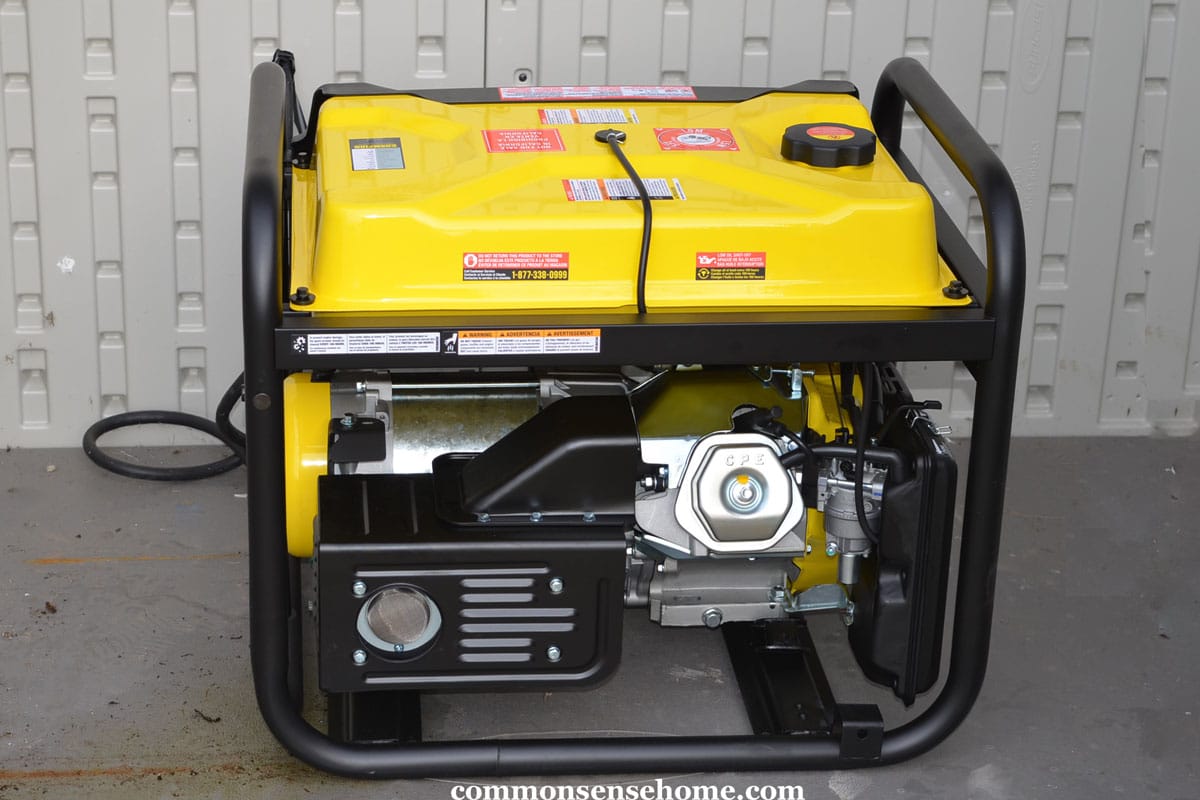
How do I keep the food cold and the house warm? When will the power come back on? How do I keep the phone charged so I can maintain contact with the outside world?
We discuss ways to provide power during a short or long power outage. Some are portable short term emergency power systems, some are permanently installed systems.
Table of contents
Sub Panel & Transfer Switch
A generator, solar panel or battery system doesn’t need to back-up your entire house. Limit your load to vital items on a second smaller breaker panel or “sub panel” and you simplify what you need to provide power to.
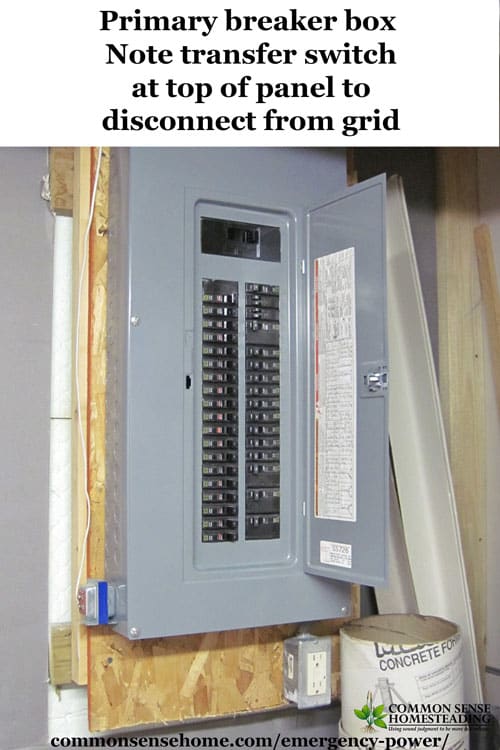
Above is a picture of our main breaker panel. It has a 200 amp feed. This panel can be manually isolated from the grid with the main 200amp breaker at the top.
Below is a picture of our sub panel or emergency 30amp panel. This panel has our freezers, refrigerator, well pump, sump pump and other critical circuits.
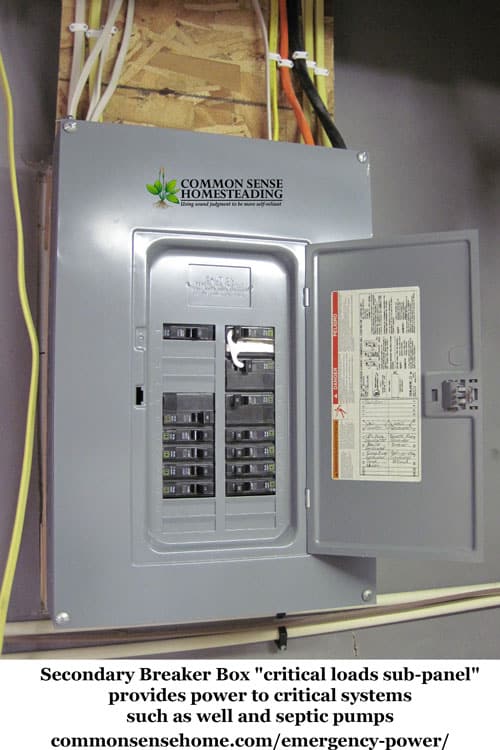
If you plan ahead, you can have a transfer switch installed next to your existing electrical panel. If you note above there is an odd breaker in the panel. That is a “double pull double throw” breaker. When we flip that the panel is disconnected from the grid and the power from the generator is enabled.
The transfer switch (or double pull double throw breaker) prevents you from back-feeding the utility grid by isolating your generator from the main panel.
This stops power from backfeeding into the grid and electrocuting a lineman who is fixing the power outage. Some systems do this automatically, referred to as service disconnect.
Gas Generator
The simplest emergency power option is to get a gas generator and a couple cans of gasoline. Use long extension cords to vital items like your refrigerator, sump pump or freezer. Appliances are generally easy to power from a generator – they have cords attached.
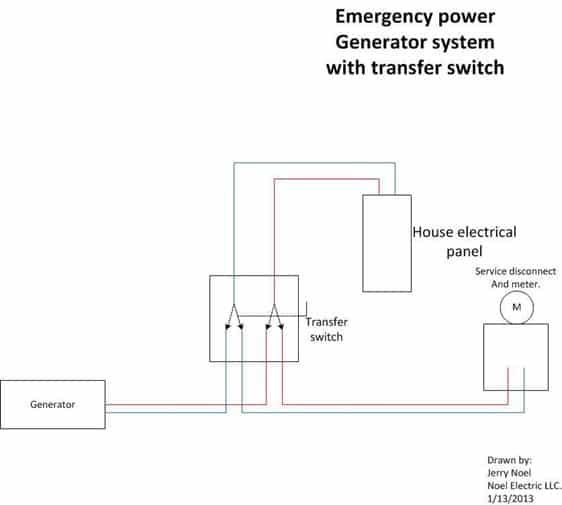
Powering larger loads like your furnace is more difficult. You would have to open the wiring junction box and splice in a cord end. This is easy for an electrician to “jerry-rig” it but not recommended for the average homeowner.
Editor’s note: Top photo in the post is our generator “dog house”, which is hard wired into our home power system. Photos below show primary and secondary breaker boxes in our home.
Gas Generator Pros:
- Power when you need it
- Portability
- Relatively inexpensive
Gas Generator Cons:
- Noisy
- Needs refueling
- Smelly exhaust
- Requires regular maintenance
- Fixed power capacity
A generator has a rated power output measured in watts or kilowatts. They can also produce small bursts of power needed for motors starting, but then go back to their rated amount. If you aren’t using much power, the generator still is running, wasting energy. A small generator can cost a few hundred to over a thousand dollars.
The bad news, gasoline doesn’t store well long term. You need to use STABIL if you want to store gasoline more than six months. Another way is to use your gas regularly in vehicles and then get fresh gas in your gas tanks.
Top Reviewed Gas Generators
- Sportsman GEN2000, 1400 Running Watts/2000 Starting Watts, Gas Powered Portable Generator
- DuroStar DS4000S, 3300 Running Watts/4000 Starting Watts, Gas Powered Portable Generator
- Champion Power Equipment 100165 7500 Watt Dual Fuel Portable Generator with Electric Start (We have this one)
- DuroMax XP12000E 12000W Portable Gas Electric Start Generator
Editor’s note: We put our generator in a Suncast BMS4700 The Stow-Away Horizontal Storage Shed. We modified it by putting vent louvers in the ends for air flow and cut a hole through on of the doors for the exhaust pipe.
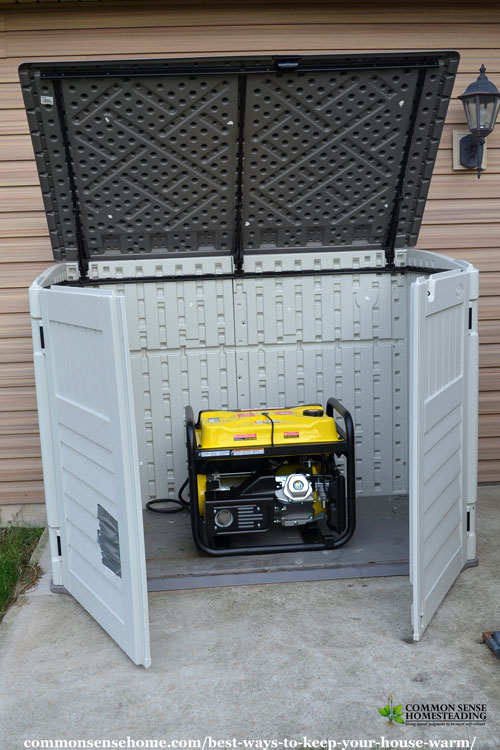
Small holes were punched in back of the unit so the plugs could reach the tie in on the side of the garage. The unit is hard wired to jumper cables so we can use car batteries from inside the garage to start the generator.
Dual Fuel Generator
When our 20+ year old gasoline generator died in 2017 we researched. We still like the gasoline generators and wanted the flexibility of using gasoline. But we wanted more options. We started looking around and found dual fuel gasoline and LPG (propane) generators.
After researching even more we settled on the Champion Power Equipment 100165 7500 Watt Dual Fuel Portable Generator with Electric Start. The price on Amazon was high, so we hunted for a better price. You will probably want to search through Amazon or other sellers. We ended up finding it locally for a bit less.
An alternative is the TriFuel 10kw/8kw Champion Generator available from Tractor Supply.
The main advantage of the Dual Fuel unit, is that we already have propane, and were considering another large tank for backup anyway. It was not overly expensive so fit all our needs.
Would you like to save this?
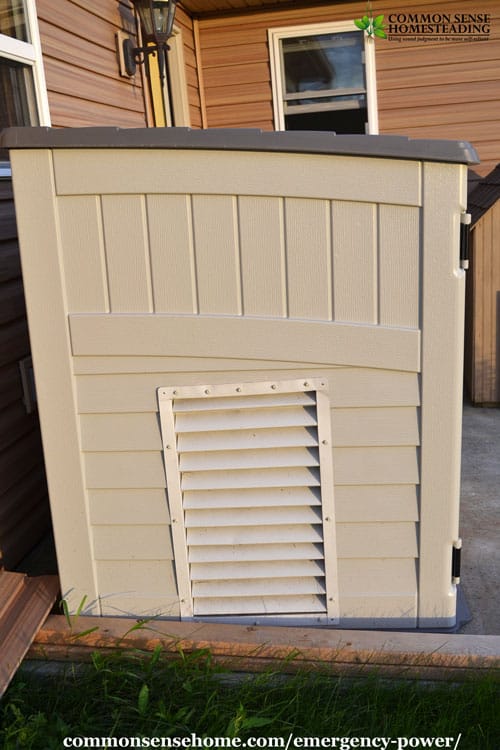
Whole House Battery Backup
Next option on the emergency electrical power food chain are Battery Backed-Up Systems. These are not car batteries, but deep cycle ones. They are heavier, more expensive, and designed differently.
Battery Backed-up systems have a battery bank that is connected to an inverter. The inverter changes the 12v or 24v DC voltage to a usable 120/240v AC voltage used in your house. Then the inverter is connected to the critical load panel through the transfer switch.
Some hybrid inverters already incorporate the transfer switch internally, connecting automatically – fast enough that your electronic items won’t know that there is an outage.
Suggested Deep Cycle Batteries
- Mighty Max ML35-12 – 12V 35AH U1 Deep Cycle AGM Solar Battery
- VMAX Solar Vmaxtanks Vmaxslr125 AGM Deep Cycle 12v 125ah SLA rechargeable Battery for Use with Pv Solar Panels,Smart chargers wind Turbine and Inverters
- Mighty 12V 100 Amp-Hour AGM SLA Deep Cycle VRLA Battery RV, Solar, Wind, Marine, Off – Grid
Whole House Battery Backup System Pros:
- Quiet operation
- No gas exhaust
- Cordless
- No refilling a gas tank
Whole House Battery Backup System Cons:
- Expensive
- Cheaper batteries require maintenance
- Requires a more advanced AC/DC invetrer.
- Limited amount of power available before they need to be recharged
- Requires solar, wind, grid-tie and/or a generator to recharge them during prolonged outages
Depending on the batteries, inverter and generator, one hour of generator run time can keep the batteries charged for hours. For short interruptions lasting only a couple hours, the batteries can keep things going and then recharge when the power returns.
Solar Power
Solar Panels provide DC power. To get AC power you need an inverter. Solar panels convert sunlight into direct current power (DC). Most homes run off AC (alternating current) so you need an inverter to convert DC to AC.
Solar panels last about 20 years. You can estimate costs at approximately $2000 to $2500 per kilowatt (but the prices are changing). Most people will need a professional installer to assist.
Most systems require permits, and some areas may have laws governing the use of solar. A 5kw system will cost $7,000 to $18,000. A 10kw system will cost $19k to $30k.
Solar Pros
- You get power anytime the sun shines
- Fairly maintenance free (other than cleaning snow or debris off the panels)
- Lasts 20 years
Solar Cons
- Requires an inverter
- Requires battery or generator if you need power in the dark
- Expensive
- Needs physical space

Other Portable Options
To provide lighting and power for small electric devices, consider solar or crank powered lamps and chargers. We’ve added a several solar and crank products to our emergency preparedness supplies, including:
A lantern with a solar panel and hand crank for charging that also has a USB charger built in for charging cell phones and other small electronics, LED Crank flashlights and Emergency radio with solar panel, crank power, flashlight and cellphone charger.
For short outages, having a little light and contact with the outside world can make the time fly much faster. The new LED products provide a lot more light at a fraction of the power requirements of older flashlights (see our Favorite Flashlight and our Brightest Flashlights).
Lamps often come with different lighting levels (like the one above), so you can set it bright enough for reading or turn it down to night light level to conserve power. These three options are all light and portable, and would also be handy for camping.
Biolite now offers products that provide power directly from a small camp stove, so you can do double (or triple) duty with one piece of equipment – cook or heat water, charge a phone, and provide lighting.
For heating, consider a Mr. Heater unit rated for indoor use with a small propane tank.

Related Articles

This post was written by August Neverman IV. August served on several emergency preparedness teams during his tenure at Brown County, and at a 13 hospital system, as well as undergoing emergency response training during his time with the Air National Guard.

Hi Laurie – do you still like the solar options you linked to in this post? Also do you have thoughts on a solar 1000watt-ish generator? So many companies and none seem to really stand out re: reliability – goal zero, inergy, jackery, etc. Thanks—the negative reviews are really giving me pause on all of these!
Given that we’ve had very little sun for the last two months, I wouldn’t recommend a solar generator for critical power needs in our area. (Wisconsin/Michigan) Our big solar electric array has been producing almost no power. If folks actually have sun, then yes, these brands are still some of the better ones.
If you want to be able to power your critical electric needs, get a generator that runs on natural gas or propane (whichever is default in your area). Gasoline generators are functional, but as gas sits it starts to break down. Ethanol laced gas is the bane of small engines. Even with Stable added, I don’t trust it to sit for any length of time.
Yes, I am concerned about the sun issue as well. Do you think having a solar option (the ones I am looking at–some have a way to charge ahead of time, which is great but of course will only last so long–they would not be for powering whole house) as a backup is a good idea or not worth it at all given your comment re: our shared sun problem.
Yes, I’m thinking about other fuel options as well.
Thanks so much for your help!
I wouldn’t count on solar in our area.
Actually, you missed part of the generator option. A dedicated, automatic, back-up system. They can be run off of natural gas or propane, are hardwired into your house, with all the switching to isolate you from the grid included in the install, and they are large enough to run you’re entire house – anywhere from 7kW to 15kW. The downside is that at around $4000-$5000, plus installation, they are fairly expensive, they definitely require planning ahead, and they’re definitely not portable – pretty much a permanent installation.
Thanks for your input.
I love the storage you have for your Dual Fuel unit. May I ask where you got it? I had considered a natural gas whole house generator, but then I read if the power grid goes down so does the natural gas. Is that accurate ?
We got a mini storage shed like this one, then we added extra vents on the ends and an exhaust port on the front.
I can’t remember if we ordered online or were able to find it at a local hardware store, as August and our sons tackled setting it up.
Yes, natural gas will probably stay on for a time, but with an extended outage, it is subject to failure, too. How long it will stay available depends on the backups at the local utilities.
For everybody that does live in an area where natural gas is available as your primary source of fuel for heating. Please, do not forget that in the event of a major catastrophe (i.e. an earthquake, or a major mudslide, or flood.). Your gas supply may be cut off due to breaks in the lines, so converting your generators to natural gas might be something that you might want to think twice about. But, if you do convert, think about having an alternate power backup…..just saying..
Very good point.
If you want to save 90+% in fuel cost install a natural gas line and convert your generator to natural gas. If your handy you can do the conversion for about 5 bucks or you can get a kit for about 120.00. The different in cost is dollars to penny’s a day.
Oh and hook your propane grill to your new natural gas line also, never have to deal with the tanks again. And again its the differences to dollars to penny’s.
That actually does not work so well. Propane needs a smaller orifice than natural gas, which is why gas stoves & dryers need a conversion kit to run on propane. I ran my water heater & furnace on propane in a self-induced emergency severeal years back. Lots of large, yellow flames, that left lots of soot tracks, instead of the clean, efficient, blue flames normally produced.
No natural gas available in our area.
Also, if it is piped NG by a utility or a city does it require pumping by electric pumps? No electricity no pumps… you may be better off with your own propane tank.
I may be mistaken, but I think there would be a limited reserve of natural gas in the lines due to it being a pressurized system, but that wouldn’t last very long in an extended outage.
Great article, Laurie! I had honestly not thought about battery backup and just doing a general “critical loads sub-panel”… makes perfect sense! Kudos!!
Thanks, Patrick. We tried to make everything as durable and useful as possible. There are still some things I would tweak, but overall it’s worked out well.
We have been looking for a way to be free of the grid in winter. There are numerous power outages from wind storms lasting from 4 hr. to 6 days. Our water is dependent on a submersible well pump, also the gas furnace and our freezers require power. All the rest like TV and lights we can get by without. Option #2 ,battery backup , looks to be the best system for us. We have a 4500 portable generator but will need to invest in switching and some batteries. I have been told to check on the batteries used for golf carts.
I have purchased a couple of these generators blueprints from the web selling for $49 and worth about .49 cents. We even had a solar contractor bid on setting the house up on solar panels. His bid was over $100 K. For that price we could move to Florida each winter. Any suggestions??? We are located in rural W Washington.
Warner, send me the information (with address so I can look it up on Google Earth) for that $100K quote so I can see what is going on (jerry-noel@hotmail.com). There is no reason I can think of for it to be that high other than gouging. Maybe I can design a better and cheaper one for you to shop around out there with. For $100K I can drive out from Wisconsin and install one!
You can do it for $10,000 or less now that panels are less expensive. It is based on what you want to be able to use in the outage. In my area, NE WA, 1 kw of solar panels gives me 2+kw in Dec and Jan. This is enough to run the refigerator. In a cool area of the house you can turn it off for half the day and let it run during the sun times. I have a 4000 w inverter that runs my well, 120 v well pump.
What you can do without will help the price immensely. Keep in mind that only the first 2 strings of batteries charge. If you want many batteries you will have to have more charge controllers.
1)8000kw northern lights generater
2)outback inverter
3)surrette batteries
4) auto start on gen.
5)diesel fuel tank 500 gallon
6) propane powered on demand hot water.
7) solar panels with tracker.
After 15 years off grid, you learn a thing or two. This is an expensive system. But my batteries will run a 2300 sq foot home for 24-36 hours depending on load. I use propane for cooking and hot water. At the time I had the money to build the system. Batteries last 10-20 years depending on how many cycles.
my question is this if anyone has suggestions…can I run my coal furnace using a deep cell battery and inverter? My biggest fear is losing power in the winter and not having enough fuel to power a generator long enough to maintain heat. If I had multiple batteries/inverters I could just run generator to recharge them. Thoughts??
First you need to determine the load that the furnace would draw, then you should be able to size the backup power system accordingly. I’m not familiar with coal furnaces, so I don’t have a feel for what your load may be, but you should be able to determine that information from the manufacturer.
I have a 6500 Watt Generator and a 5000 Watt unit…both converted to LP/Gas. When in LP mode, I can run my fuel line from a custom manifold off of my 500 gallon house tank. Although I am limited on what I can run, NOT having to re-fuel or store large amounts of gas is worth it…
I was hoping you’d chime in. Did your gas company have any liability issues with this?
My LP provider installed it for me! On the plus side, I run the house off of one tank. IF (and it did) run out of fuel, I just close the valve on the empty tank and open the one on the full tank…and re-light my furnace.
Also, during a power outage, I JUST run what is NEEDED to!!! I have a woodstove for heat… No need to light up your house like nothings wrong…you will become a beacon for crime!
Thanks, CJ. We have light blocking shades on all the windows, but you can’t be too careful when things get bad.
I cannot stress this enough…you will NOT be able to run everything you WANT off of ANY small generator. You CAN run just what you NEED though you will have to allocate power to certain circuits at different times. I also run the generator in a 1 hour on/2 hour off rotation (during warmer months) to keep the freezers cold. In the winter months, my power needs change….frozen stuff can just be put outside!
Also, keep in mind that the noise from a running generator WILL travel!….especially at night! Your neighbors WILL show up!….or worse! IF noise is an issue, I would suggest either a built in stand alone/automatic back up system….or, if you want to stay portable….look at spending the extra on a Honda unit….VERY QUIET!
Adding a muffler to a portable unit does NOT make it quiet….it will tone it down a bit but….
Also, have a spot for your unit that has proper airflow. Portable units are aircooled so placing them in a shed (and operating it there!) could cause problems with cooling….
Just some random thoughts….
Exhaust building up in closed shed could easily be dangerous, too. Emergency power is generally just that – critical systems only. If you reduce your electrical needs, you’ll be able to meet a greater percentage of them with a smaller system. As you mentioned, take advantage of natural conditions, and switch to non-electric options when possible.
Nice, no non-sense article. Plus, give me a big “duh!” (slaps forehead) on using a generator to replenish a battery bank! Although solar is our goal, as your article states, cost is a factor. We have a smaller 6,000 watt generator we ran through a bypass/transfer panel that runs our necessary items but lacks being able to run our main home heater and we resort to smaller room heaters, but that keeps things warm enough!